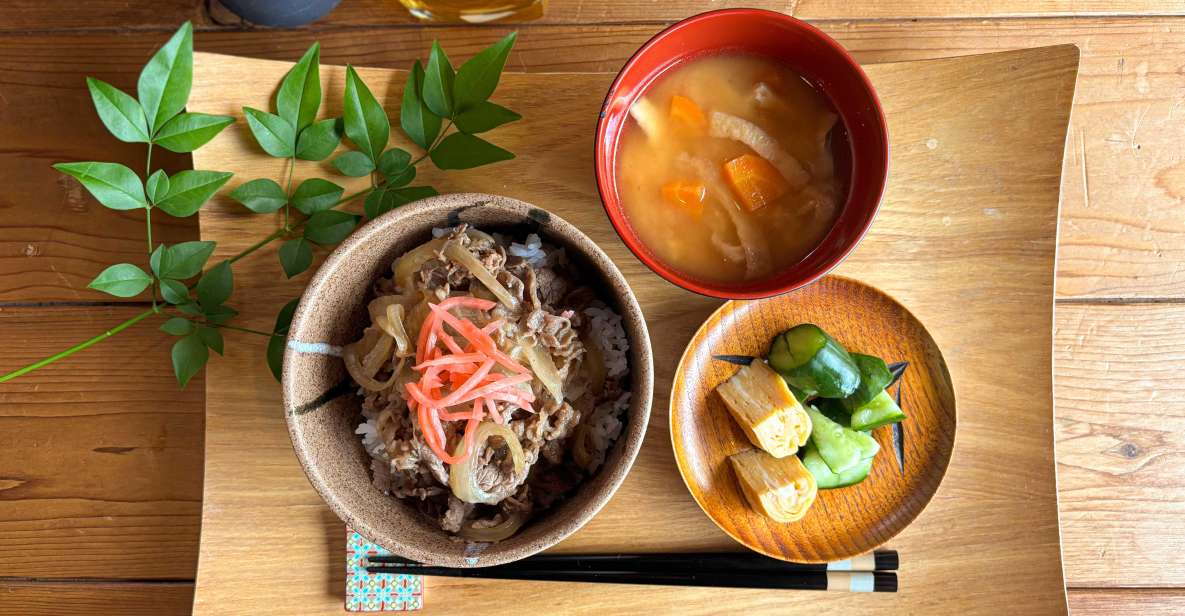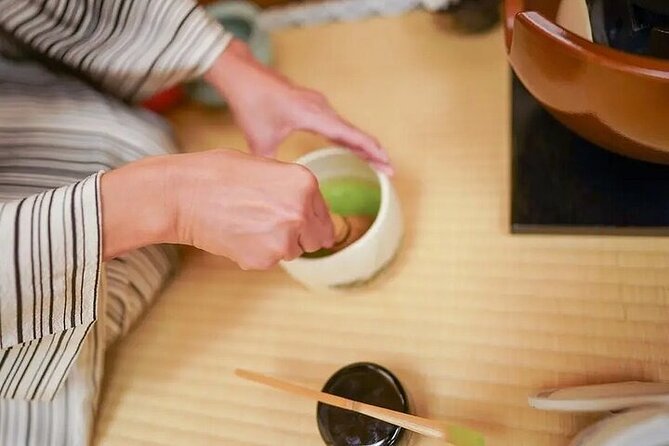The Ubiquitous Japanese Beef Rice Bowlgyudon With Side Dishe

In a world where simplicity meets sublime flavors, the unassuming Gyudon beef rice bowl reigns as a staple in Japanese cuisine.
As diners across the globe savor the comforting allure of thinly sliced beef simmered in a sweet soy-based sauce atop a bed of steaming rice, the intrigue behind this dish continues to captivate curious minds.
But what makes Gyudon truly irresistible? Stay tuned as we unravel the secrets behind this ubiquitous Japanese favorite and its perfect companions, promising a culinary journey worth embarking on.
More nearby cooking classses we've reviewed
Key Points
- Gyudon is a beloved Japanese dish with a rich history and widespread popularity.
- The dish offers a balanced meal with protein-rich beef, fiber from onions, and essential nutrients.
- Pair Gyudon with miso soup, pickled vegetables, and green tea for a satisfying dining experience.
- Gyudon’s simplicity, nutritional benefits, and versatility make it a favorite among Japanese foodies.
It's also worth checking out some other tours and experiences nearby.
Origin of Gyudon
The origin of Gyudon can be traced back to late 19th-century Japan when it gained popularity as a quick and convenient meal option for busy city dwellers. This dish, deeply rooted in Japanese culinary traditions, combines thinly sliced beef, onions, and a savory-sweet sauce served over a bowl of steamed rice.
Gyudon, meaning ‘beef bowl’ in Japanese, holds a significant place in the beef bowl history of Japan, evolving over the years to become a beloved comfort food for many. Its simplicity and delicious flavors have made it a staple in Japanese cuisine, offering a satisfying and hearty meal for people on the go.
Over time, Gyudon has become a symbol of convenience without compromising on taste within the realm of Japanese gastronomy.
Ingredients for Gyudon

For making Gyudon, you’ll need thinly sliced beef, onions, and a savory-sweet sauce served over a bowl of steamed rice.
The thinly sliced Japanese beef is a key component of this popular rice bowl dish, providing a rich and tender texture.
The onions add a sweet and aromatic flavor profile to complement the savory beef.
The sauce, typically made with ingredients like soy sauce, sake, sugar, and seasonings, creates a delicious umami-packed coating for the beef and onions.
When these ingredients come together over a bed of steamed rice, they form the hearty and comforting Gyudon dish that has become a staple in Japanese cuisine.
The simplicity of these ingredients allows for the flavors to shine through in every bite of this satisfying rice bowl.
Cooking Process for Gyudon
To cook Gyudon, start by thinly slicing the beef and onions for optimal flavor infusion. Slicing against the grain helps to tenderize the beef.
Heat a pan and add the beef, onions, and a mixture of dashi, soy sauce, mirin, and sugar. Let the ingredients simmer until the beef is cooked through and the onions are translucent, allowing the flavors to meld together.
The sweetness from the mirin, saltiness from the soy sauce, and savory umami from the dashi create rich flavor profiles in the dish. Cooking techniques like simmering and stir-frying are essential to ensure the beef is tender and the sauce thickens slightly.
Once done, serve the Gyudon over a bowl of steamed rice for a satisfying meal.
Side Dishes to Pair With Gyudon
Pair Gyudon with a selection of traditional Japanese side dishes to enhance the overall dining experience.
-
Flavor pairings: Consider adding a side of miso soup to complement the savory flavors of Gyudon. The umami-rich broth of miso soup balances well with the beefy richness of the Gyudon.
-
Japanese condiments: Offer a side of pickled vegetables such as tsukemono to provide a crunchy and tangy contrast to the tender Gyudon. The acidity of the pickles can help cleanse the palate between bites of the flavorful beef bowl.
-
Beverage pairings: For a traditional drink pairing, serve green tea alongside Gyudon. The earthy notes of green tea can cleanse the palate and enhance the overall dining experience with its subtle flavors.
Health Benefits of Gyudon
Indulging in Gyudon can offer individuals a protein-rich meal with a balance of carbohydrates, making it a satisfying and nourishing choice. Gyudon, a staple in Japanese cuisine, provides various nutritional benefits. The beef in Gyudon is a significant source of protein, essential for muscle growth and repair. Plus, the rice offers a good source of carbohydrates for energy. The dish also contains onions, which provide fiber and vitamin C. On top of that, the cultural significance of Gyudon lies in its popularity as a quick, hearty meal enjoyed by people of all ages in Japan. Below is a table summarizing the key nutritional benefits of Gyudon:
| Nutrient | Benefits |
|---|---|
| Protein | Essential for muscle growth |
| Carbohydrates | Energy source |
| Fiber and Vit C | Supports digestive health |
Gyudon Variations and Customizations
Exploring Gyudon Variations and Customizations reveals the creative adaptability of this traditional Japanese beef rice bowl, offering a spectrum of flavors to suit diverse preferences.
When customizing gyudon, you can enjoy a range of variety options such as adding vegetables like onions, mushrooms, or bell peppers to enhance the dish. Experimenting with different seasoning blends, from spicy chili flakes to fragrant garlic, opens up endless flavor combinations.
On top of that, for those seeking a richer experience, topping gyudon with a perfectly cooked soft-boiled egg or a dollop of creamy mayonnaise can elevate the dish to new heights. These variations showcase the versatility of gyudon, allowing enthusiasts to tailor their bowls to their unique taste preferences.
Frequently Asked Questions
Can I Request a Vegetarian or Vegan Version of Gyudon During the Cooking Class?
In the cooking class, participants can’t request a vegetarian or vegan version of Gyudon. However, the English-speaking instructor can offer flavorful substitutions and meatless options for those looking for vegetarian alternatives during the cooking experience.
Are There Any Specific Techniques or Tips for Achieving the Perfect Texture and Flavor in Gyudon Beef Bowl?
To achieve the perfect texture and flavor in Gyudon beef bowl, use thinly sliced meat cuts for tenderness. Marinating secrets include soaking beef in a mixture of sake, soy sauce, sugar, and seasonings for enhanced flavor profiles. Master these cooking techniques for a delicious dish.
Is There a Recommended Beverage Pairing That Complements the Flavors of Gyudon?
When enjoying Gyudon, a sake pairing enhances the flavors with its subtle notes, reflecting culinary traditions. Alternatively, a tea pairing brings out the rich umami taste. These beverage choices complement the bold flavors of the beef bowl.
Are There Any Traditional Etiquette or Customs Associated With Eating Gyudon in Japan?
When enjoying gyudon in Japan, individuals typically adhere to chopstick etiquette and cultural customs. Dining traditions emphasize eating quietly, not sticking chopsticks upright in rice, and showing appreciation for the meal. These table manners reflect respect for the food and hosts.
Can Participants Take Home Any Leftovers From the Cooking Class, or Are They Expected to Finish Everything During the Session?
Participants are encouraged to finish their dishes during the cooking class. While there are no takeout options for leftovers, portion control is emphasized to minimize food waste. Leftover etiquette is to enjoy the meal fully on-site.
Recap
To sum it up, mastering the art of Gyudon and its accompanying side dishes offers a delightful journey into the heart of Japanese home cooking.
With a balance of flavors and textures, this iconic beef rice bowl is sure to satisfy your culinary cravings.
Explore the rich tradition of Japanese cuisine through this immersive experience, and bring a taste of Japan into your own kitchen with these authentic recipes.






